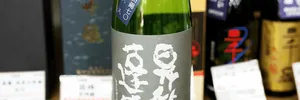SakenowaRecord your sake experiences and discover your favorites
昇龍蓬莱Shoryuhorai
Flavor Chart®
A chart created from flavor analysis of user comments.

Flavor Tags ®
Tags generated from flavor analysis of user comments.
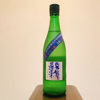
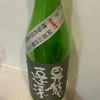
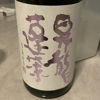
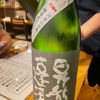
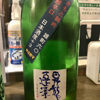
Popular Comments
I had wanted to drink it for a long time, but the timing was never quite right... The manager said it was his favorite drink in the restaurant!
It is a pale yellow color with silver tints and a hint of green.
It has a spicy top note with a hint of alcohol, but the aroma is very refreshing, perhaps because of the acidity.
When you drink it, the slightly carbonated texture on the tongue is pleasant. There is not much noticeable aroma, but the acidity gives it a refreshing mouthfeel.
It may not have much sweetness to begin with, but the acidity helps to make it dry. Despite its dryness, it has a strong flavor, which is probably due to the strong umami that can be tasted from start to finish. Dry sake is usually considered "spicy," but perhaps because of the strong umami, it does not feel too spicy.
Interestingly, it is a sake that does not have much bitterness, which may be why it is so light and easy to drink despite its 17% alcohol content.
This is seriously very, very good! I wouldn't say it's for everyone, but I think it's a must-try for sake drinkers who like umami!
Japanese>English
Low-polished & sake yeast yeast
As expected, it has a strong punch!
The aftertaste is also bitter and punchy. ‼️
It has a beautiful mouthfeel and a citrusy bitterness at the finish.
It is easy to drink with just the right amount of sweetness.
It was a unique and delicious sake with many different expressions. ❣️
Japanese>English
Rice used is Yamadanishiki
After opening the bottle, I wondered if it would have been better if I had let it sit longer.
I regret it after opening the bottle.
Even as it is, it has a great balance of fruity and powerful, with a clean dry finish. ‼️
However, it seemed to have a lot of potential to improve!
It was delicious, but it was a waste of time!
Japanese>English
Brands from Ooyatakashi Shuzo
Similar Brands
We analyze the flavors based on everyone's comments and select similar brands.
Shichihon'yariSimilar Characteristics
IzumibashiSimilar Characteristics
Location
521 Tashiro, Aikawa, Aikō-gun, KanagawaOpen in Google Maps
Timeline
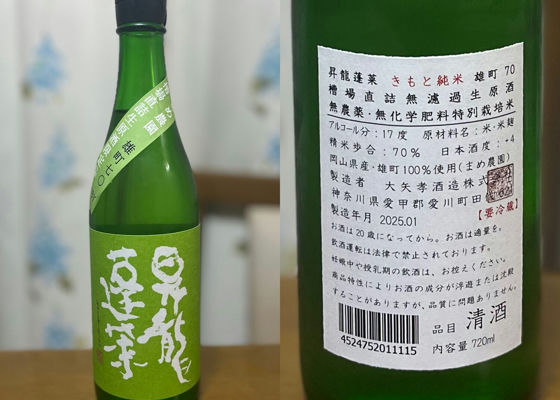
ひぃやん
Sake of the Day
Shoryu Horai
Kimoto Junmai Omachi 70
Unrefined unpasteurized sake straight from the tank
100% Omachi from Okayama Prefecture (Mame Farm)
Rice polishing ratio: 70
Alcohol content: 17%.
Sake degree: +4
Japanese>English
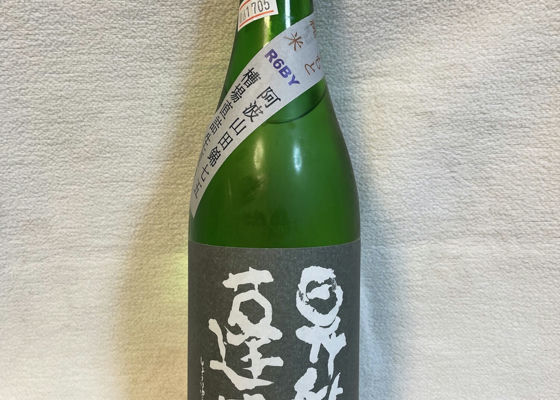
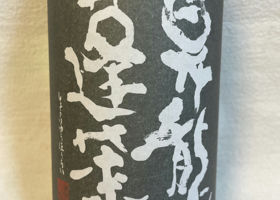
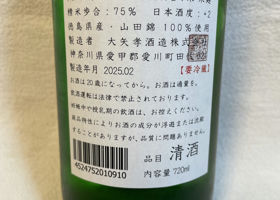
パーム農家
Shoryu Hourai Kimoto Junmai.
It has a sweet aroma of grains mixed with a fresh cucumber aroma. The taste has a sweetness reminiscent of melon and acidity typical of a sake brewed using the "kamoto" method, and the powerful umami of the sake spreads with a strong bubbling sensation. It is different from Zanzou Horai in terms of strength and full of umami. When there are both, it is hard to decide which one to buy. It is good when I can afford to buy both.
Japanese>English
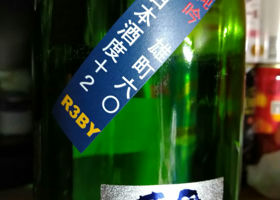
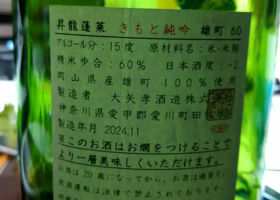
夢茶苦茶也
Mellow and delicious mouthfeel
Just as the label says!
Delicious!
It seems to be a sake brewed in the same way as Omachi!
It is R3BY but was produced in November 2024.
Alcohol 15%.
Rice polishing ratio 60
Sake degree +2
Japanese>English
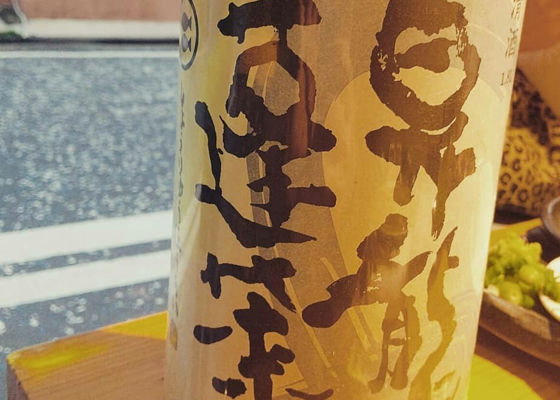
ぷちこ
野毛にて
Shoryuhorai生酛阿波山田錦七五純米まろやかな原酒
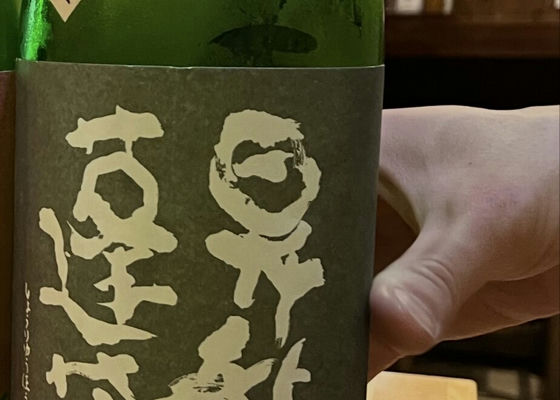
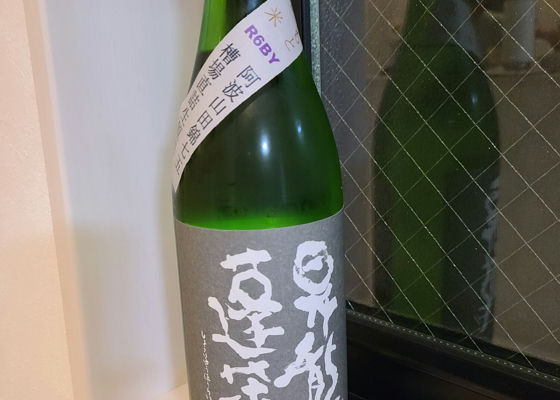
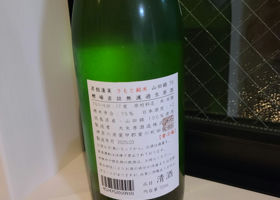
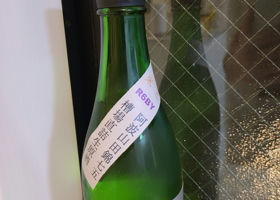
kazumin
The 18th bottle this year, Shoryu Horai, is delicious.
Japanese>English

ひぃやん
Sake of the Day
Shoryu Horai
Kimoto Jungin Yamadanishiki 60
Dry master, please give me a break.
Unrefined unpasteurized sake directly from the tank
100% Yamadanishiki produced in Tokushima Prefecture
Rice polishing ratio: 60
Alcohol content: 17%.
Sake meter: +16
Japanese>English
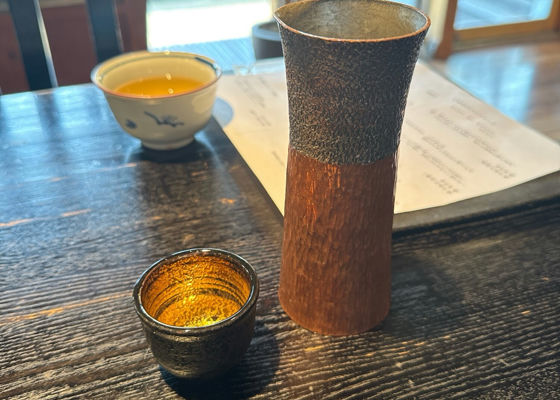
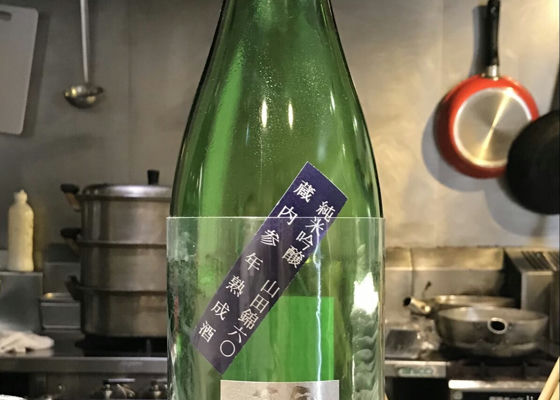
key-key
Preference ★★★☆☆☆☆☆
Japanese>English
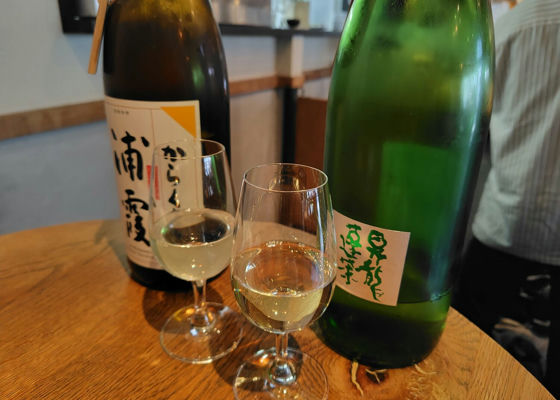
Hisa ˎˊ˗
Hot: Good
Cold:
Chinese>English

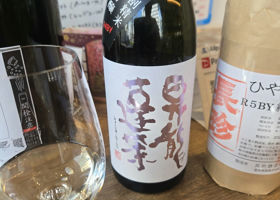
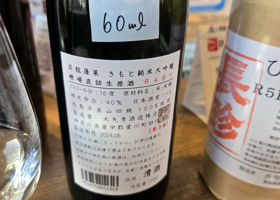
コジコジ
It has an aroma of alcohol, a mouthfeel like matured sake, and a dry taste (though it lingers a little). It should be drunk chilled. Tokushima Yamadanishiki 40
Japanese>English
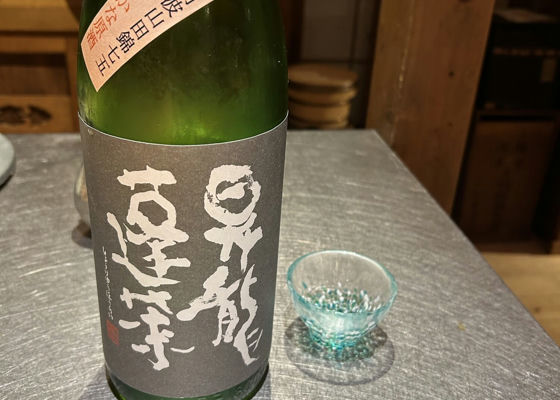
Shoryuhoraiきもと純米 山田錦 75 槽場直詰無濾過生原酒
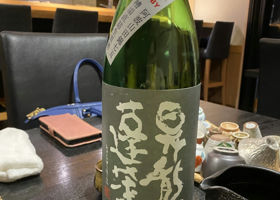
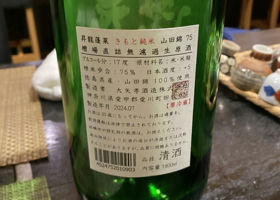
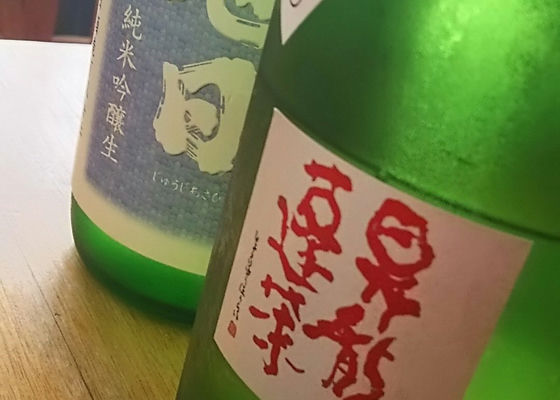
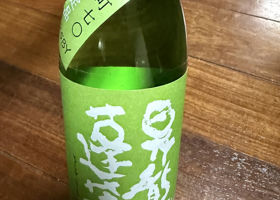
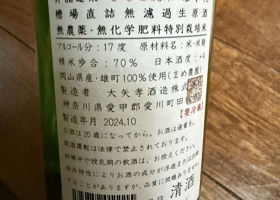
takan
.
Happy New Year ㊗️!
New Year's Day is a day of good luck,
We had a limited edition of Shoryu Hourai, a raw sake directly from the vat! It has a slightly fizzy, fruity, pear-like taste on the palate, with a delightful finish that will make your tongue squeal at the back of your mouth.
It is a very enjoyable sake from a farm that is very particular about its farm and fresh production method.
I bought this sake when I was in Kamakura and would buy it again.
Japanese>English
ma-ki-
Happy New Year, takan 🎍.
I look forward to working with you again this year 🙇.
Japanese>English
Manta
takan-san
Happy New Year ^_^
I look forward to working with you again this year🙇.
Japanese>English
ジェイ&ノビィ
Happy New Year, takan 🌅.
We also had our first drink a while ago 😋! We had our first drink a while ago too 😋It's a very auspicious name for the New Year 👍I'd like to try the Zanso one too🤗.
We look forward to working with you again this year: 🙇🏻
Japanese>English
takan
MA-KI-,
Thank you for your comment! I will try to find an opportunity to drink a lot this year! Thank you very much!
Japanese>English
takan
Mr. Jay & Nobby,
Thanks for your comments! I'm still keeping my Senkou Snowball too.
I would like to drink it again on a cold day. Thank you again for your support this year!
Japanese>English
takan
Manta-san, thank you for your continued support. I am drinking the remaining Shoryu Hourai today. I look forward to working with you again this year!
Japanese>English
Shoryuhoraiきもと純米 山田錦75 槽場直詰無濾過生原酒

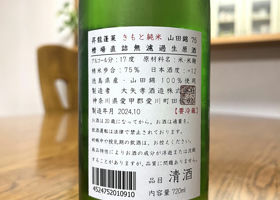
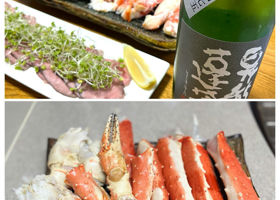
ジェイ&ノビィ
I've been wanting to try this for a while! I got it at Isetan Shinjuku after lunch at epicurean a while ago👍This is the first time to drink Shoryu Yomogina at home🤗.
I'll make love to you!
I'll make love to you! I'm not sure what to expect, but I'm sure I'm going to have to wait until I get to the next one to find out.
Thank goodness we have the same taste buds 😚.
If our tastes and preferences didn't match, we would have been in constant trouble and bottles of sake would have been flying around every day 😱.
By the way, there was a little incident with the codfish that sat on the table that day💦.
One day I came home to find a delivery slip for a crab delivery with the sender's name Jay... but I don't remember it at all 🙄.
I thought 🤔 this might be a fraud 🤔 and looked at the internet information, and it seems that there is indeed such a thing, and if you look closely, the phone number of the sender is also suspicious 😰.
I called the courier to return it because I was scared.
I was talking about how glad I was that I didn't get cheated, and then my sister Jay, who had called to confirm just in case, called to say "I sent it as a surprise"...eh~⁉️😱 Oh no 💦.
I called the courier in a dash and succeeded in retrieving the crabs: 😮💨
Beware of mistakes, folks 😉.
Japanese>English
ETENE
Hi Jay & Nobby 😃
It seems to be a rather unusual tasting sake! I'm very interested in it.
I hope to try it soon 🍶.
Japanese>English
ポンちゃん
Hi Jay & Nobby 🐦.
That's a magnificent 🦀😻Surprise to receive it and surprise to find out it was from your sister, that was too much of a surprise 😆.
You two are adults who know what bitterness tastes like 👍we're just kids 😂.
Japanese>English
マナチー
Hi Jay & Nobby 😃You should have given me the crab instead of returning it 🤣I haven't had a proper crab yet this year 🦀.
Japanese>English
ヒロ
Hi Jay & Nobby, ☀️
It's important to have similar tastes 😁.
Especially for drinkers, the bottle is the murder weapon 🙄🙄.
I'm jealous of your surprise crab 🦀 🥹 our surprise was radishes 🤣.
Japanese>English
ヤスベェ
Hi Jay & Nobby 😀
We have the same taste in alcohol in our family, so we manage to make it work, but it would be a disaster if we had different tastes 🤣.
It's really a sad world when we can't enjoy surprises 😅.
Japanese>English
@水橋
Hi Jay & Nobby 😃.
I see you have a good story to tell. I remember a long time ago, I received a phone call from a fat guy who sent a courier to my office and told me that he would send the young man if I didn't transfer the money 💦.
Japanese>English
ひなはなママ
Hi Jay & Nobby 😃Hello 😃The sake here is +12 dry 😅I'm impressed 👍I still can't afford it 💦It's important for a couple to have compatible tastes and interests 💕But then again 🦀! A pleasant surprise would be very welcome 🦀❣️
Japanese>English
Takashi
Hi Jay & Nobby 😊.
Ascending Dragon Hourai, you went 🎉.
And by the way, you are a good couple 🥳.
Indeed, the crabs we didn't ask for are a bit scary 😱.
The washing machine that was supposed to come today AM at our house still hasn't arrived, 😩.
Japanese>English
N.E
Hi Jay & Nobby 😆
That's a very lucky brand name 🐲.
It's a little bit Chinese restaurant 🤭.
I'm sure you are the best representative of a loving couple 🏆.
Safe to say that Mr. 🦀 didn't escape 💦.
Japanese>English
はなぴん
Good evening, Jay & Nobby. 😊
In this day and age, you are right to be skeptical.
I am very sad to hear that, but it made me think about it.
I am so sorry for your loss. I was saved by a 😞 nice surprise.
I was saved by a nice surprise 😞. I was saved by a nice surprise 😂Roast beef? I'm curious about the roast beef.
I'm curious😍.
Japanese>English
T.KISO
Good evening, Jay & Nobby😄!
I want to eat crab 🦀 so bad!!!! I'm so hungry 😋!
It's the top 3 things I crave for at the end of the year 😁💕.
Japanese>English
まえちん
Hi Jay & Nobby 🌇😀😀
I'm really glad the crab 🦀 came back 😚👍 If it had failed, you both would have fallen over bubbling, 🫧🦀🦀🫧 blowing 🦀🤣
Japanese>English
soumacho
Good evening, Jay & Nobby 😃.
I envy your same hobbies and taste preferences 🥺.
My wife and I share the same taste in travel, but not in food and drink 😵.
Well, the food she cooks for us is delicious 😙.
Japanese>English
さしゅー
Jay & Nobby Good evening😄Shenglong Hourai! I had never had it before. I guess it's important to have the same taste buds! And the crab was really good! Surprises are also something to think about.
Japanese>English
こぞう
Mr. Jay & Mrs. Nobby
Good evening...
Crab, I'm glad you got it safely 😅.
Shoryu Hourai's Oyataka sake brewery has a lot of dry sake.
I haven't had it for a few years now, but I can buy it anytime I want so it's hard to get my hands on it😅.
Japanese>English
ma-ki-
Good morning, Jay & Nobby.
You are indeed Jay's sister ⤴️
And the crab looks delicious 🦀.
Looks like it would go great with dry sake 🎵.
Glad you enjoyed it without all the sake bottles flying around 😁✨✨.
Japanese>English
ジャイヴ
Hi Jay & Nobby!
I didn't know there was another "Shoryu Horai" besides "Zanso Horai"💦.
The splendid king crab 🦀 looks delicious, but you have to think carefully about the surprise or you might get into trouble 🤔.
Japanese>English
ジェイ&ノビィ
Hello ETENE 😃
I think maybe different drinkers have different impressions of the taste 🤔 Please give it a try 👋
Japanese>English
ジェイ&ノビィ
Hi Pon 😃
I just found out that my sister apparently ordered it from Jay with the wrong sender's name 😆 It had an unusual flavor but was delicious 😙.
Japanese>English
ジェイ&ノビィ
Hi Manachy 😃
Ahh! You're right 🦀‼️ I should have sent you a cash on delivery 😆 You can have as many crabs as you want 😋.
Japanese>English
ジェイ&ノビィ
Hi Hiro 😃
It's true 😊The incident in Utsunomiya! When the news comes out that the murder weapon was a sake bottle ‼️... think you did it 😏🤣!
Japanese>English
ジェイ&ノビィ
Hi Yasbay 😃.
It must be hard if you and your wife drink and have opposite tastes 🥲I would have simply been happy if the sender was my sister's name 😅I didn't know what it was 😰... 😰.
Japanese>English
ジェイ&ノビィ
Hello, @Mizuhashi!
I'm sorry, but I want to post a story with an ending right away 😅Yeah, I heard that I was charged for opening the door 😰... 😰I'm afraid.
Japanese>English
ジェイ&ノビィ
Hi HinaHanaMama 😃
I think you might like to try it out for a drink outside as it has a sweetness to it 😋I would welcome a gift 🎁 that has a clear sender 🤗.
Japanese>English
ジェイ&ノビィ
Hi Takashi 😃
As you can imagine it was to our liking 😋Next time I would like to taste the leftover grass too 🤗Yes, you don't know who it is 😨Did the washing machine come 😁?
Japanese>English
ジェイ&ノビィ
Hi N.E. 😃
Yes, it's true! It's a bit like an expensive Chinese restaurant 🐉 🤔 Well, we are a moderately matured and dry couple 🤣.
Safe 🦀!
Japanese>English
ジェイ&ノビィ
Hi, Hanapin 😃.
You're right... it's sad that doubt comes first 😢I'm glad the outcome was ok🤗.
That's as expected! I had the roast beef with sprouts on top 😋.
Japanese>English
ジェイ&ノビィ
Hi T.KISO 😃
It's true that ‼️ crab🦀 is prominent this time of the year and I want to eat it 😋I wonder if I can eat it one more time 🤔If not, I'll have a little expensive crabcakes 😆.
Japanese>English
ジェイ&ノビィ
Hi Maechen 😃
I'm glad to hear from my sister so quickly 😮💨 I made a re-delivery for the next day, but the delivery came late and I had to check many times, just by the voice on the phone, it's crab, right? I could remember that 😅.
Japanese>English
ジェイ&ノビィ
Hello, soumacho 😃.
Really! We are both happy to have such a fun and wonderful hobby 🤗It's important to have the same taste in travel 😊.
Japanese>English
ジェイ&ノビィ
Hi Sashu 😃
I still have a lot of sake 🍶 that I've never had 😅I can't miss both tastes 👅 and crabs 🦀 😆.
Japanese>English
ジェイ&ノビィ
Hi Kojo 😃
If you think after the crab 🦀 has been returned 😱 I shudder to think...here, we were the first to see it, but I guess the locals are easy to get 🤗.
Japanese>English
ジェイ&ノビィ
Hi ma-ki-😃.
I was happy to hear your sister's sentiments 🥹 but I wish you had named me 😆 A good dry sake and crab 🦀 would make for a peaceful evening 😌.
Japanese>English
ジェイ&ノビィ
Hi Jive 😃
We also learned about it from Takashi's post 🤗I'd love to try the leftover yomogina 😙It was really a magnificent crab 🦀 and very satisfying 😋Surprise alert 😅.
Japanese>English
りなこ
Jay & Nobby, good evening 🌇oh! Ascending Dragon Hourai🐲Last month of the Year of the Dragon, maybe your luck will rise ⤴️ with the dragon for next year!
Japanese>English
ジェイ&ノビィ
Good evening, Rinako 😃.
We went for a drink at home 🤗Arakan and his wife also enjoyed it 😋It is true 🐉I hope your luck will rise ⤴️ like it did 😁.
Japanese>English
